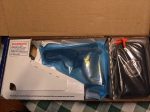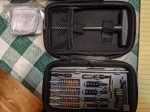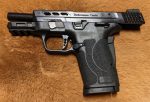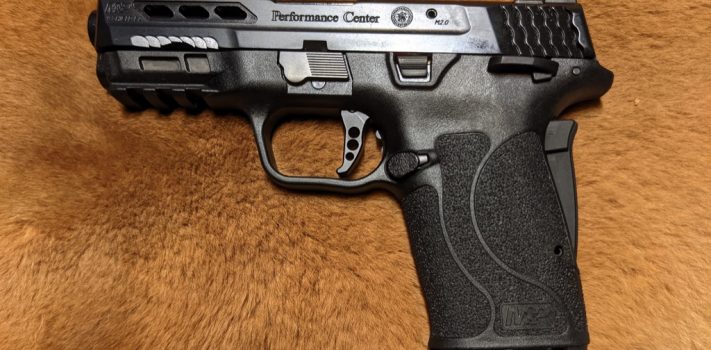This is my review and range report on the Smith and Wesson Performance Center M&P9 Shield “EZ” variant.
The Smith and Wesson Performance Center M&P9 Shield EZ is an easily-loaded and easily-racked 9mm handgun with the best overall handgun sights that I have ever used. I am not really a fan of the grip safety, and I wish that the sights were adjustable for elevation as well as windage. Other than that, I can’t think of any way to improve this fine design.
The Backstory
A friend of mine, “Running Man”, recently acquired his first handgun. It was entrusted to him by his father. The handgun is a beautiful, stainless steel Smith and Wesson 4586 in .45 ACP. His father had acquired the 4586 some years ago when his local police department made the transition from .45 ACP to 9 mm.
Running Man brought the 4586 over for a familiarization session. We reviewed the basics of firearms safety, field stripped and cleaned the 4586 to see what makes it tick, talked a little about range safety, worked on how to effectively grip the 4586, and then practiced firing it with both paper and steel targets.
The heavy, solid steel construction of the 4586 did a great job of moderating the recoil of the .45 ACP cartridge. I do not particularly like double-action-only triggers, but this one was smooth enough that I was able to shoot fairly decent groups with it. Running Man proved himself to be a good natural shot. I felt that he and the 4586 are well-matched, with one major exception.
The one major exception is the recoil spring. It is a bit on the heavy side, making racking the slide somewhat difficult.
Several years ago, Running Man got a virus with flu-like symptoms. The virus migrated to his heart, and caused the muscle to begin to deteriorate. Ultimately, Running Man needed a heart transplant.
One of the procedures associated with the heart transplant damaged the nerves running down Running Man’s left arm. As a result, the thumb and index finger of his left hand are numb and weak. The heavy recoil spring on the 4586 makes it extremely difficult for Running Man to rack the slide.
The MP9 EZ
I had previously read about the easily racked slide of the M&P Shield EZ by Smith and Wesson. I had thought about how that feature might be useful to someone with weakness in their non-dominant hand. Now I knew someone who could personally benefit from that feature. With that in mind, I contacted Smith and Wesson so see if I could borrow an MP9 EZ for testing and evaluation. They were kind enough to agree.
They asked me which model of the MP9 EZ I wanted to borrow. After due consideration, I asked for the one with all of the bells and whistles: I requested the Performance Center M&P9 Shield EZ. Among other special features, it includes a ported barrel, hybrid tritium/fiber optic sights, and a cleaning kit. These and other special features give the Performance Center version a MSRP of $624, which is $119 higher than the basic, no-frills version of the “EZ” handgun.
Opening the Box
A couple of weeks later, the MP9 EZ arrived at my FFL. I picked it up, and brought it home.
 The MP9 EZ arrived in a cardboard box. I was initially inclined to feel that the cardboard box was unworthy of the precisely machined object that it contained. This was particularly true since the cleaning kit that came with the handgun was in a better case than the handgun itself. Upon reflection, I remembered that in other reviews I have complained about manufacturers spending money on packaging that could be better invested in the product itself. So I give a nod to Smith and Wesson in this case for having their priorities in the right place.
The MP9 EZ arrived in a cardboard box. I was initially inclined to feel that the cardboard box was unworthy of the precisely machined object that it contained. This was particularly true since the cleaning kit that came with the handgun was in a better case than the handgun itself. Upon reflection, I remembered that in other reviews I have complained about manufacturers spending money on packaging that could be better invested in the product itself. So I give a nod to Smith and Wesson in this case for having their priorities in the right place.
Upon opening the box, I found the handgun in a plastic bag; two single-stack, eight-round magazines; an empty chamber flag; a lock; a small Allen wrench; a registration card; a California firearms warning card; a manual; and the above mentioned cleaning kit.
The cleaning kit was in a padded, black, zippered case containing directions, cleaning patches, a cleaning rod that breaks down into two sections, two patch loops (one larger and one smaller), four jags in various sizes, brass brushes in four sizes, a pick, and a nylon brush.
I was really impressed with the hybrid tritium/fiber optic sights. I found them extremely easy to acquire under a wide range of ambient light conditions, from total darkness to bright sunlight. I have not tested their long term durability under field conditions, and they are not adjustable for elevation. But in every other way they are the best handgun sights that I have ever used.
Next, I read the manual, which began with basic firearms safety rules, and repeated them throughout. This is necessary, since many may not read the manual in its entirety. But the repetition does get a little boring at times.
There were a number of other items of note. The manual warns against the use of +P+ ammunition in the MP9 EZ. It advises that the handgun should be cleaned prior to first use. The manual was clearly written and well-illustrated. It noted that the handgun is capable of firing with the magazine removed. The magazine has load-assist buttons on both sides like the buttons that are often on one side of magazines for handguns chambered in 22 LR.
The manual warns against loading rounds directly into the open ejection port, and advises instead that rounds should only be chambered from the magazine.
The manual advises a 30-second wait with the handgun pointed in a safe direction after a misfire. Field stripping is a very straightforward process. In contrast with many modern handguns, the firearm uses an internal hammer rather than a striker.
It is important not to depress the grip safety while removing or reinstalling the slide. Doing so causes the firing pin plunger lever to rise, which may interfere with the movement of the slide.
The recoil spring assembly has to be oriented so that the round portions of the breech end are located at the top and bottom, and the flat portions are located at the sides. I forgot to do this one time during reassembly, and could not figure out what was interfering with the process.
The manual includes detailed magazine disassembly and reassembly instructions. The magazine release is user reversible. As I have previously mentioned, the rear sight is adjustable for windage only.
The handgun has a limited warranty for one year only. It is also warranted for the lifetime of the original owner if the warranty card is submitted within 30 days of purchase.
There were some special warnings related to the ported barrel. Because of the hot gasses being channeled through the port, it is inadvisable to fire the handgun from the hip or from a retention position.
First Cleaning
In accord with the recommendations of the manual, I cleaned the handgun prior to firing it. This allowed me to remove the excess shipping oil, which was generously applied; to test the included cleaning kit; and to familiarize myself with the handgun.
I found the handgun to be extremely easy to field strip.
 The rod in the cleaning kit consisted of two sections that are designed to screw together. The threading with which the sections screw together is different than the threading of the various tips that screw onto the rod. This means that although one section of the rod would have been long enough to go through the entire barrel, both sections of the rod needed to be used. This is because the tips could not be screwed directly into the handle section of the rod, but only into the tip section. It would be more versatile to thread the second rod section in the same way as the tips, so that the user could decide whether they wanted to use just one section of the rod or both.
The rod in the cleaning kit consisted of two sections that are designed to screw together. The threading with which the sections screw together is different than the threading of the various tips that screw onto the rod. This means that although one section of the rod would have been long enough to go through the entire barrel, both sections of the rod needed to be used. This is because the tips could not be screwed directly into the handle section of the rod, but only into the tip section. It would be more versatile to thread the second rod section in the same way as the tips, so that the user could decide whether they wanted to use just one section of the rod or both.
I began the cleaning process by using a dry patch to remove excess shipping oil. The shipping oil was surprisingly dirty.
It was nice that a pick was included in the cleaning kit, but I found that the pick tended to loosen (unscrew) from the rod during use. I eventually admitted defeat, and just held the prick directly in my hand rather than attaching it to the rod.
It was difficult at first to thread one of the brass brushes onto the rod. The threading of either the brush or rod was poorly executed.
As I was cleaning the slide, I was reminded that I am not a big fan of slots cut into the sides of slides. These may let dirt and lint into the interior of the slide under field use.
Overall, I felt that the cleaning kit was well-conceived and functional.
Home on the Range
I scheduled a range day with a bunch of friends to test the gun. When the big day arrived, I made my way out to the range before my friends arrived to do some preliminary testing.
 I found the load assist buttons on the magazine to be very effective at making the task of loading the magazine easier. I felt that the slide release button was smaller than I would have preferred, but it was easy to release the slide by pulling the slide back instead. The sights are absolutely outstanding. I would like to have sights like these on all of my handguns. But I would like those sights to be adjustable for elevation as well as windage. I tended to shoot a couple of inches too low at five yards, and six inches too low at 15.
I found the load assist buttons on the magazine to be very effective at making the task of loading the magazine easier. I felt that the slide release button was smaller than I would have preferred, but it was easy to release the slide by pulling the slide back instead. The sights are absolutely outstanding. I would like to have sights like these on all of my handguns. But I would like those sights to be adjustable for elevation as well as windage. I tended to shoot a couple of inches too low at five yards, and six inches too low at 15.
My groups were reasonably tight for a handgun of this size. So all in all my first impressions at the range were good.
After the gang arrived, they all tried the M&P9 EZ as well. Here are their impressions:
“The Natural” found loading the magazine easier, which was nice. He found his shots grouping about two inches low from five yards. He liked the way the gun felt in his hand, and the way it felt when he fired it, perhaps due to the port on the barrel.
“The New Guy” liked loading the magazine. He found the grip safety to be a bit stiff, but really liked the trigger. He liked the sights best of all. His shots also seemed to group a little low. He found the appearance of the gun to be attractive.
“Welly” liked the way the gun fit his hand, and the tightness of his groups. He was not a fan of the grip safety. The fact that the slide was easy to rack was helpful, since Welly has arthritis in his hands. Overall, he liked the gun.
“Running Man” found the magazine easy to load. He found the ease of loading magazine and of racking the slide to be a great benefit, due to the nerve damage in his left hand. He also felt that the trigger pull was nice and smooth. The grip safety was a new experience for him, but it did not impede his enjoyment of the gun.
I took another turn at the firing line. As I released the slide to chamber a round, the magazine fell out of the gun. It is amazing that a round chambered successfully almost simultaneously with the magazine falling out. I am not sure if I somehow bumped the magazine release while releasing the slide. It took me a few minutes to get all the sand cleaned out of the magazine. This is the only time we experienced this problem during that range session.
During the Natural’s second trip to the firing line his shots did not group as low as during his first trip. He wondered if perhaps he was aiming more carefully during his second trip. He also began to find the grip safety somewhat irritating.
“The Messenger” had a good first impression, liking in particular the grip and sights. He found the gun to be light, easy to load, and the slide easy to rack. He noted that the trigger reset is very short, but that it is difficult to feel the point at which it resets.
“Midas” found the gun light, and easy to shoot, and found it easy to acquire the sights. He is left handed, so he appreciated the ambidextrous safety and magazine release.
Dry Fire Practice
In the days following the first range session, I decided that some dry fire practice would be in order. This would allow me to further familiarize myself with the firearm without the burden of the high cost of ammunition.
For my dry fire practice, I used the Mantis X10, which I previously reviewed in an article that was published on SurvivalBlog on February 11, 2020.
My dry fire practice consisted of two sessions on two different days. Each session consisted of five 10 shot groups. The Mantis X10 rates shots on a scale from 1 to 100. During the first session I averaged 94.9. During the second session I averaged 95.6.
I had not really noticed the grip safety during my initial live fire practice, but during the dry fire practice I began to find it irritating. This was probably because I took more shots during the dry fire sessions than I had taken during the first live fire session. As I took shot after shot, there was just something about the grip safety that did not feel right in my hand. I know that this is a matter of personal taste, but I just don’t like it.
My love for the sights continued to deepen during the dry fire sessions. I conducted the dry fire sessions indoors, where the lighting was not as good as I usually experience during live-fire sessions at my outdoor range. The sights were much easier to acquire in a low light setting than the sights on any other handgun that I have ever used, with the obvious exception of red dot sights, which are sometimes hard to acquire in bright sunlight. The hybrid tritium/fiber optic sights are easy to acquire in all light settings.
The dry fire practice was easy to do in the later evening when it would have been too dark to use the outdoor range, I did not have to buy any ammo, and I did not need to clean the handgun afterward.
The Final Range Session
Several days later, on a cool and windy November day, I went out to the range behind the barn for the final range session. I was shooting Blazer aluminum cased 115 grain FMJ ammo.
I noticed again how the buttons on the magazine made loading much easier, how the slide was still easy to retract, and that the sights were still great.
My first group was decently spaced, but about five inches low from 15 yards. For my remaining groups I aimed about five inches high, and received satisfactory results. This made me wish again for a way to adjust the sights for elevation.
On my fourth group, the magazine fell out as I chambered a round. This had also happened during the first range session. I am not sure if I did not have it locked fully in place, or if I somehow hit the magazine release button. I would want to explore this issue thoroughly before employing this handgun for self defense.
On my fifth group, the bullet in one of the cartridges appeared to be too deeply seated, but there was no noticeable impact on performance.
Conclusions
Smith and Wesson has done an excellent job of making a handgun that is easy to load and easy to rack. It is appropriately accurate for its size.
The hybrid tritium/fiber optic sights are absolutely outstanding. I wish that they could be adjusted for elevation as well as windage.
I did have a couple of instances of the magazine falling out after chambering the first round. I would want that issue clarified before trusting this handgun with my life.
Disclaimer
Smith and Wesson was kind enough to loan me a sample of their Performance Center M&P9 Shield EZ for testing and evaluation. I tried not to let their kindness interfere with my objectivity, and believe that I have succeeded. I had received a sample of the Mantis X10 for review for an earlier article. I did not receive any other financial or other inducements to mention any vendor, product, or service in this article.










